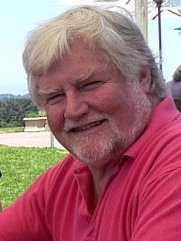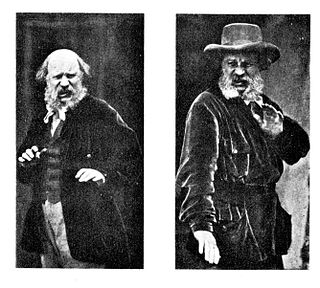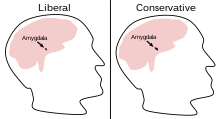A political spectrum is a system to characterize and classify different political positions in relation to one another. These positions sit upon one or more geometric axes that represent independent political dimensions. The expressions political compass and political map are used to refer to the political spectrum as well, especially to popular two-dimensional models of it.

In the human brain, the anterior cingulate cortex (ACC) is the frontal part of the cingulate cortex that resembles a "collar" surrounding the frontal part of the corpus callosum. It consists of Brodmann areas 24, 32, and 33.

Brodmann area 9, or BA9, refers to a cytoarchitecturally defined portion of the frontal cortex in the brain of humans and other primates. Its cytoarchitecture is referred to as granular due to the concentration of granule cells in layer IV. It contributes to the dorsolateral and medial prefrontal cortex.
Social dominance orientation (SDO) is a personality trait measuring an individual's support for social hierarchy and the extent to which they desire their in-group be superior to out-groups. SDO is conceptualized under social dominance theory as a measure of individual differences in levels of group-based discrimination; that is, it is a measure of an individual's preference for hierarchy within any social system and the domination over lower-status groups. It is a predisposition toward anti-egalitarianism within and between groups.
In psychology, right-wing authoritarianism (RWA) is a set of attitudes, describing somebody who is highly submissive to their authority figures, acts aggressively in the name of said authorities, and is conformist in thought and behavior. The prevalence of this attitude in a population varies from culture to culture, as a person's upbringing and education play a strong role in determining whether somebody develops this sort of worldview.
Affective neuroscience is the study of how the brain processes emotions. This field combines neuroscience with the psychological study of personality, emotion, and mood. The basis of emotions and what emotions are remains an issue of debate within the field of affective neuroscience.

The posterior cingulate cortex (PCC) is the caudal part of the cingulate cortex, located posterior to the anterior cingulate cortex. This is the upper part of the "limbic lobe". The cingulate cortex is made up of an area around the midline of the brain. Surrounding areas include the retrosplenial cortex and the precuneus.
System justification theory is a theory within social psychology that system-justifying beliefs serve a psychologically palliative function. It proposes that people have several underlying needs, which vary from individual to individual, that can be satisfied by the defense and justification of the status quo, even when the system may be disadvantageous to certain people. People have epistemic, existential, and relational needs that are met by and manifest as ideological support for the prevailing structure of social, economic, and political norms. Need for order and stability, and thus resistance to change or alternatives, for example, can be a motivator for individuals to see the status quo as good, legitimate, and even desirable.
The simulation theory of empathy holds that humans anticipate and make sense of the behavior of others by activating mental processes that, if they culminated in action, would produce similar behavior. This includes intentional behavior as well as the expression of emotions. The theory says that children use their own emotions to predict what others will do; we project our own mental states onto others.

Glenn Daniel Wilson is a psychologist best known for his work on attitude and personality measurement, sexual attraction, deviation and dysfunction, partner compatibility, and psychology applied to performing arts. He is a fellow of the British Psychological Society and makes frequent media appearances as a psychology expert, especially in TV news and documentaries.
Genopolitics is the study of the genetic basis of political behavior and attitudes. It combines behavior genetics, psychology, and political science and it is closely related to the emerging fields of neuropolitics and political physiology.

Disgust is an emotional response of rejection or revulsion to something potentially contagious or something considered offensive, distasteful or unpleasant. In The Expression of the Emotions in Man and Animals, Charles Darwin wrote that disgust is a sensation that refers to something revolting. Disgust is experienced primarily in relation to the sense of taste, and secondarily to anything which causes a similar feeling by sense of smell, touch, or vision. Musically sensitive people may even be disgusted by the cacophony of inharmonious sounds. Research has continually proven a relationship between disgust and anxiety disorders such as arachnophobia, blood-injection-injury type phobias, and contamination fear related obsessive–compulsive disorder.
Cultural neuroscience is a field of research that focuses on the interrelation between a human's cultural environment and neurobiological systems. The field particularly incorporates ideas and perspectives from related domains like anthropology, psychology, and cognitive neuroscience to study sociocultural influences on human behaviors. Such impacts on behavior are often measured using various neuroimaging methods, through which cross-cultural variability in neural activity can be examined.

Meditation and its effect on brain activity and the central nervous system became a focus of collaborative research in neuroscience, psychology and neurobiology during the latter half of the 20th century. Research on meditation sought to define and characterize various practices. The effects of meditation on the brain can be broken up into two categories: state changes and trait changes, respectively alterations in brain activities during the act of meditating and changes that are the outcome of long-term practice.
Neuropolitics is a science which investigates the interplay between the brain and politics. It combines work from a variety of scientific fields which includes neuroscience, political science, psychology, behavioral genetics, primatology, and ethology. Often, neuropolitics research borrow methods from cognitive neuroscience to investigate classic questions from political science such as how people make political decisions, form political / ideological attitudes, evaluate political candidates, and interact in political coalitions. However, another line of research considers the role that evolving political competition has had on the development of the brain in humans and other species. The research in neuropolitics often intersects with work in genopolitics, political psychology, political physiology, sociobiology, neuroeconomics, and neurolaw.
Moral foundations theory is a social psychological theory intended to explain the origins of and variation in human moral reasoning on the basis of innate, modular foundations. It was first proposed by the psychologists Jonathan Haidt, Craig Joseph, and Jesse Graham, building on the work of cultural anthropologist Richard Shweder. More recently, Mohammad Atari, Jesse Graham, and Jonathan Haidt have revised some aspects of the theory and developed new measurement tools. The theory has been developed by a diverse group of collaborators and popularized in Haidt's book The Righteous Mind. The theory proposes that morality is "more than one thing", first arguing for five foundations, and later expanding for six foundations :
Neuroimaging intelligence testing concerns the use of neuroimaging techniques to evaluate human intelligence. Neuroimaging technology has advanced such that scientists hope to use neuroimaging increasingly for investigations of brain function related to IQ.

Mindfulness has been defined in modern psychological terms as "paying attention to relevant aspects of experience in a nonjudgmental manner", and maintaining attention on present moment experience with an attitude of openness and acceptance. Meditation is a platform used to achieve mindfulness. Both practices, mindfulness and meditation, have been "directly inspired from the Buddhist tradition" and have been widely promoted by Jon Kabat-Zinn. Mindfulness meditation has been shown to have a positive impact on several psychiatric problems such as depression and therefore has formed the basis of mindfulness programs such as mindfulness-based cognitive therapy, mindfulness-based stress reduction and mindfulness-based pain management. The applications of mindfulness meditation are well established, however the mechanisms that underlie this practice are yet to be fully understood. Many tests and studies on soldiers with PTSD have shown tremendous positive results in decreasing stress levels and being able to cope with problems of the past, paving the way for more tests and studies to normalize and accept mindful based meditation and research, not only for soldiers with PTSD, but numerous mental inabilities or disabilities.
In psychologist Hans Eysenck's P–E–N model of personality, psychoticism is a trait which is typified by aggressiveness and interpersonal hostility. In 2010, a paper titled "The nature of the relationship between personality traits and political attitudes" claimed to find a strong positive correlation between conservatism and psychoticism. This error was repeated in subsequent papers by the same authors; however, around 2015, the authors acknowledged the correlation is actually negative rather than positive, and began issuing corrections.
Peter K. Hatemi is an American political scientist and Distinguished Professor of Political Science, co-fund in Microbiology and Biochemistry at Pennsylvania State University. He is known for his research on the relationship between genetic factors and political attitudes and ideologies, the influence of narcissism on political attitudes as well as the underpinnings of violent behavior. He has also studied the relationship that other factors have to political orientations, finding that an individual's personality traits or moral foundations have no causal role in one's political orientations, but rather, that if there is a causal path, it is from political orientations to one's morals and personality traits.







